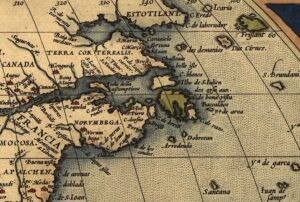Glastonbury Abbey was everything I had imagined it to be, old, elegant ruins and an atmosphere of mystery. A strong obsession with fantasy and legends permeated my childhood and I begged my family to take me to every Middle Age and Medieval site we could manage. Occupying my thoughts in Glastonbury Abbey was the Once and Future King: King Arthur.
It is a name we have all heard. This iconic messianic king of Britain, who defeated evildoers with Excalibur and was mentored by Merlin, has inspired many a movie and novel.
But where do these fantastical stories begin? Arthurian legend has a distinctly romantic and medieval character but elements of the story stretch back to the Roman Empire’s exit from Britain and the arrival of the Angles, Saxons, and other “barbarian” hoards.
Fact or fiction?
A leader named Arthur was first mentioned in the 800s in a text called Historia Brittonum or The History of the Britons. It was written by a Welsh monk named Nennius who purportedly documented the entire history of Britain up to the point of the work’s composition.
Nennius paints Arthur as a military leader who fought around 12 important battles against the Saxons. Arthur was again mentioned in the Annales Cambriae, a 10th-century chronicle that also portrays him as a leader against the Saxons. The writer marks his death at the hand of Medraut at the Battle of Camlann in 537 AD.

Illustration from Our Island Story by Henrietta Elizabeth Marshall.
Arthur makes brief appearances in a few subsequent manuscripts before his life’s story is written in Geoffrey of Monmouth’s 12th-century Historia Regum Britanniae or History of the Kings of Britain. Here, Arthur first gains the title ‘King of the Britons.’ However, this is also the point where things become highly convoluted.
Monmouth’s Historia became very popular and circulated all over Europe. Readers took the events of the text as truth. But Historia is a pseudo-history/chronicle that blends fact and fiction. Historians believe Monmouth composed it with a patriotic purpose in mind, highlighting the greatness of British kings with elements of the supernatural and folklore. He exaggerates and invents tales, despite claiming that he was only translating an older text.
Monmouth’s Arthurian tale begins with his conception at Tintagel Castle (located in Cornwall). The wizard Merlin puts a spell on Uther Pendragon, giving him the appearance of Gorlois, Duke of Cornwall so he can sleep with the Duke’s wife, Ygraine. They sleep together and Arthur is born.
Fifteen years later, Arthur assumes the throne when Pendragon dies, defeats several foes, and forges an empire stretching from Ireland to Gaul. Later, his nephew Mordred betrays him, stealing Arthur’s wife, Guinevere. Arthur returns to kill him but is fatally wounded in battle. He subsequently disappears to the Isle of Avalon.
Arthur as a literary figure
After Monmouth, Arthurian legend ventures from the historical (or pseudo-historical) realm into a literary genre: Arthurian romance.
Arthurian romance is birthed from the works of Chrétien de Troyes. Building upon Monmouth’s accounts, this French poet brought in new characters and concepts. He introduced the knights of the round table, the sword in the stone, and the quest for the Holy Grail. Chrétien de Troyes paints Arthur as a just king, embodying virtue and chivalry. In contrast to Monmouth’s portrayal of him as a fierce and skilled warrior who enjoyed killing, de Troyes sees him as a refined man of honor.

Knight sculpture at Tintagel. Photo: Cornwalls.co.uk
The Arthurian literary tradition continues with writers Jacques de Guise and, famously, Thomas Malory who wrote Le Morte D’Arthur. Arthur’s character takes on some changes in these texts. Historian Geoffrey Ashe refers to Arthur as “a shape-shifter who has taken different forms over the centuries.”
Analysis
If we’re taking Arthur’s appearances in the earlier chronicles seriously, which date him to the 400s or 500s, we need to go back to pre-Roman Britain. It was an unstable time for the island. Rome’s withdrawal left a power vacuum, fertile ground for the Saxons and the Angles.
It is possible that there was a Roman or British military leader who stood against the invaders. Some historians suggest a promising candidate, a Romano-British leader named Riothamus. He supposedly lived around 470 AD, fought barbarian nations, fought in Gaul, and was the ‘King of the Britons’ according to Byzantine historian Jordanes. He seems to fit the bill.
Another theory, which formed the basis of the character in the 2004 film starring Clive Owen, is that Arthur was a Roman leader named Lucius Artorius Castus. However, Lucius Artorius Castus existed one or two centuries too early, long before the Saxon invasions. Another fringe theory is that Arthur is an obscure Celtic god.
Archaeology
With a general time frame to work with, we can look into the physical evidence. Since Monmouth referred to Tintagel in his work, I visited Tintagel, a castle and fortified ruin sitting on the edge of a cliff. Relatively recent excavations dated the ruins and artifacts to the 5th and 6th centuries. From 450 AD to 650 AD, Tintagel was an important trading hub and possibly housed nobility or royalty.

Photo: Tom Ordelman/Wikipedia Commons
Another prominent site is Glastonbury Abbey. Glastonbury is a quirky town in Somerset that claims to be the final resting place for King Arthur. Glastonbury Tor (a hill nearby) is supposedly the island of Avalon.
In 1181, monks claimed to find Arthur and Guinevere’s bodies beneath the abbey with a headstone stating that “here lies interred the famous King Arthur on the Isle of Avalon.”
Too good to be true? Probably. King Henry II, who had been waging war at the time, spearheaded the search for Arthur’s resting place. Historians believe he did so to legitimize his rule. Other historians believe that the abbey priests wanted publicity to help raise money for the upkeep of the building.
Conclusion
King Arthur’s literary presence is much stronger than his archaeological presence. However, the literary traditions in the earliest Welsh texts must have started somewhere.
Personally, I believe that writers based Arthur on a military commander who staved off the advances of the Saxons. Whether he was a Roman or Briton, who knows. Perhaps oral tradition passed stories of this individual’s victories down the generations, prompting future writers to pull together their own patriotic works featuring this mythic commander.






